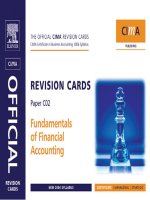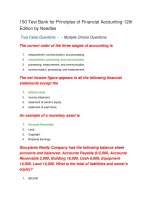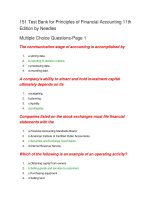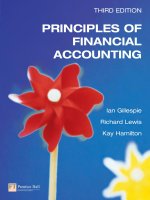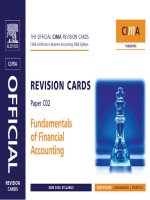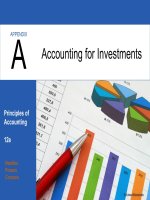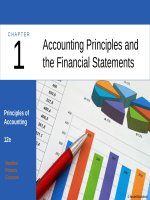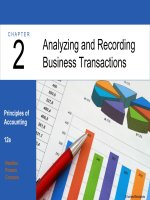Principles of financial accounting 11e by needles and powers
Bạn đang xem bản rút gọn của tài liệu. Xem và tải ngay bản đầy đủ của tài liệu tại đây (21.77 MB, 858 trang )
Principles of
Financial
Accounting
ELEVENTH EDITION
This page intentionally left blank
Principles of
Financial
Accounting
ELEVENTH EDITION
Belverd E. Needles, Jr., Ph.D., C.P.A., C.M.A.
DePaul University
Marian Powers, Ph.D.
Northwestern University
Principles of Financial Accounting,
Eleventh Edition
Belverd Needles and Marian Powers
Vice President of Editorial, Business:
Jack W. Calhoun
Editor in Chief: Rob Dewey
Executive Editor: Sharon Oblinger
Supervising Developmental Editor:
Katie Yanos
© 2011, 2008 South-Western, Cengage Learning
ALL RIGHTS RESERVED. No part of this work covered by the
copyright herein may be reproduced, transmitted, stored, or used
in any form or by any means graphic, electronic, or mechanical,
including but not limited to photocopying, recording, scanning,
digitizing, taping, web distribution, information networks, or
information storage and retrieval systems, except as permitted
under Section 107 or 108 of the 1976 United States Copyright Act,
without the prior written permission of the publisher.
Sr. Marketing Manager: Kristen Hurd
Marketing Coordinator: Heather Mooney
Sr. Marketing Communications Manager:
Libby Shipp
Content Project Manager: Darrell Frye
Media Editor: Bryan England
Editorial Assistant: Julie Warwick
For product information and technology assistance, contact
us at Cengage Learning Customer & Sales Support,
1-800-354-9706
For permission to use material from this text or product, submit
all requests online at www.cengage.com/permissions
Further permissions questions can be emailed to
Frontlist Buyer, Manufacturing: Doug Wilke
Production Service:
S4Carlisle Publishing Services
Sr. Art Director: Stacy Jenkins Shirley
Cover and Internal Designer:
Grannan Graphic Design
ExamView® is a registered trademark of eInstruction Corp.
Windows is a registered trademark of the Microsoft Corporation
used herein under license. Macintosh and Power Macintosh are
registered trademarks of Apple Computer, Inc. used herein under
license.
Cover Image: © Getty Images/Image Bank
Permissions Account Manager: John Hill
© 2011 Cengage Learning. All Rights Reserved.
Cengage Learning WebTutor™ is a trademark of Cengage Learning.
Library of Congress Control Number: 2009941181
Student Edition ISBN 10: 0-538-75516-4
Student Edition ISBN 13: 978-0-538-75516-0
Instructors Edition ISBN 10: 0-538-75529-6
Instructors Edition ISBN 13: 978-0-538-75529-0
Loose-leaf Edition ISBN 10: 0-538-75524-5
Loose-leaf Edition ISBN 13: 978-0-538-75524-5
South-Western Cengage Learning
5191 Natorp Boulevard
Mason, OH 45040
USA
Cengage Learning products are represented in Canada by
Nelson Education, Ltd.
For your course and learning solutions, visit www.cengage.com
Purchase any of our products at your local college store or at our
preferred online store www.CengageBrain.com
Printed in the United States of America
1 2 3 4 5 6 7 13 12 11 10 09
BRIEF CONTENTS
SUPPLEMENT TO CHAPTER
SUPPLEMENT TO CHAPTER
1
Uses of Accounting Information and the Financial Statements
2
Analyzing Business Transactions
3
Measuring Business Income
4
Completing the Accounting Cycle
5
Financial Reporting and Analysis
5
How to Read an Annual Report
6
The Operating Cycle and Merchandising Operations
6
Special-Purpose Journals
7
Internal Control
8
Inventories
9
Cash and Receivables
2
48
98
142
180
226
266
302
318
350
390
10 Current Liabilities and Fair Value Accounting
11 Long-Term Assets
430
472
12 Contributed Capital
518
13 Long-Term Liabilities
562
14 The Corporate Income Statement and the Statement
of Stockholders’ Equity
614
15 The Statement of Cash Flows
656
16 Financial Performance Measurement
17 Partnerships
706
754
APPENDIX
A
Accounting for investments
APPENDIX
B
Present Value Tables
794
808
v
This page intentionally left blank
CONTENTS
Preface
xv
Acknowledgements
About the Authors
CHAPTER 1
xxv
xxix
Uses of Accounting Information and the Financial Statements
DECISION POINT Ǡ A USER’S FOCUS KEEP-FIT CENTER
3
Accounting as an Information System 4
Business Goals, Activities, and Performance
Measures 4
Financial and Management Accounting 7
Processing Accounting Information 7
Ethical Financial Reporting 8
Decision Makers: The Users of Accounting
Information 10
Management 10
Users with a Direct Financial Interest 11
Users with an Indirect Financial Interest 12
Governmental and Not-for-Profit Organizations 12
Accounting Measurement 13
Business Transactions 14
Money Measure 14
Separate Entity 15
CHAPTER 2
Financial Position and the Accounting
Equation 17
Assets 18
Liabilities 18
Owner’s Equity 18
Financial Statements 19
Income Statement 19
Statement of Owner’s Equity 20
The Balance Sheet 20
Statement of Cash Flows 21
Relationships Among the Financial Statements 21
Generally Accepted Accounting Principles 24
GAAP and the Independent CPA’s Report 25
Organizations That Issue Accounting Standards 26
Other Organizations That Influence GAAP 26
Professional Conduct 27
Corporate Governance 27
The Forms of Business Organization 15
Ǡ KEEP-FIT CENTER: REVIEW PROBLEM 28
Characteristics of Corporations, Sole Proprietorships,
and Partnerships 15
STOP & REVIEW
31
CHAPTER ASSIGNMENTS
33
Analyzing Business Transactions
DECISION POINT Ǡ A USER’S FOCUS PAWS AND HOOFS
CLINIC
49
Measurement Issues 50
Recognition 50
Valuation 51
Classification 53
Ethics and Measurement Issues 53
Double-Entry System 54
Accounts 54
The T Account 54
The T Account Illustrated 55
Rules of Double-Entry Accounting 55
Normal Balance 56
Owner’s Equity Accounts 56
2
48
Business Transaction Analysis 58
Owner’s Investment to Form the Business 58
Economic Event That Is Not a Business
Transaction 59
Prepayment of Expenses in Cash 59
Purchase of an Asset on Credit 59
Purchase of an Asset Partly in Cash and Partly
on Credit 60
Payment of a Liability 60
Revenue in Cash 61
Revenue on Credit 61
Revenue Collected in Advance 61
Collection on Account 62
Expense Paid in Cash 62
vii
viii
Contents
Expense to Be Paid Later 63
Withdrawals 63
Summary of Transactions 65
The Trial Balance 65
Preparation and Use of a Trial Balance 65
Finding Trial Balance Errors 67
Cash Flows and the Timing
of Transactions 68
CHAPTER 3
Chart of Accounts 70
General Journal 70
General Ledger 72
Some Notes on Presentation 73
Ǡ PAWS AND HOOFS CLINIC: REVIEW PROBLEM 75
STOP & REVIEW
79
CHAPTER ASSIGNMENTS
81
Measuring Business Income
DECISION POINT Ǡ A USER’S FOCUS RELIABLE
ANSWERING SERVICE
99
Profitability Measurement: Issues and
Ethics 100
Net Income 100
Income Measurement Assumptions 101
Ethics and the Matching Rule 102
Accrual Accounting 104
Recognizing Revenues
Recognizing Expenses
Adjusting the Accounts
Adjustments and Ethics
CHAPTER 4
Recording and Posting Transactions 70
104
105
105
106
98
Type 2 Adjustment: Recognizing Unrecorded,
Incurred Expenses (Accrued Expenses) 111
Type 3 Adjustment: Allocating Recorded, Unearned
Revenues (Deferred Revenues) 113
Type 4 Adjustment: Recognizing Unrecorded,
Earned Revenues (Accrued Revenues) 114
A Note About Journal Entries 115
Using the Adjusted Trial Balance to Prepare
Financial Statements 116
Cash Flows from Accrual-Based
Information 119
Ǡ RELIABLE ANSWERING SERVICE: REVIEW
PROBLEM
121
The Adjustment Process 107
STOP & REVIEW
Type 1 Adjustment: Allocating Recorded Costs
(Deferred Expenses) 107
CHAPTER ASSIGNMENTS
125
127
Completing the Accounting Cycle
DECISION POINT Ǡ A USER’S FOCUS WESTWOOD
MOVERS
143
From Transactions to Financial
Statements 144
The Accounting Cycle 144
Closing Entries 144
Preparing Closing Entries 147
Step 1: Closing the Credit Balances 147
Step 2: Closing the Debit Balances 147
Step 3: Closing the Income Summary Account
Balance 147
Step 4: Closing the Withdrawals Account
Balance 147
142
The Accounts After Posting 148
The Post-Closing Trial Balance 150
Reversing Entries: An Optional First
Step 152
The Work Sheet: An Accountant’s Tool 154
Preparing the Work Sheet 154
Using the Work Sheet 157
Ǡ WESTWOOD MOVERS: REVIEW PROBLEM 158
STOP & REVIEW
160
CHAPTER ASSIGNMENTS
162
ix
Contents
CHAPTER 5
Financial Reporting and Analysis
DECISION POINT Ǡ A USER’S FOCUS FUN-FOR-FEET
COMPANY
181
Foundations of Financial Reporting 182
Objective of Financial Reporting 182
Qualitative Characteristics of Accounting
Information 182
Accounting Conventions 184
Ethical Financial Reporting 184
Accounting Conventions for Preparing
Financial Statements 185
Consistency 185
Full Disclosure (Transparency) 186
Materiality 187
Conservatism 187
Cost-Benefit 188
SUPPLEMENT TO CHAPTER 5
Classified Balance Sheet 190
Assets 190
Liabilities 192
Owner’s Equity 193
Dell’s Balance Sheets 194
Forms of the Income Statement 196
Multistep Income Statement 196
Dell’s Income Statements 199
Single-Step Income Statement 200
Using Classified Financial Statements 201
Evaluation of Liquidity 201
Evaluation of Profitability 202
Ǡ FUN-FOR-FEET COMPANY: REVIEW PROBLEM 208
STOP & REVIEW
210
CHAPTER ASSIGNMENTS
212
How to Read an Annual Report
The Components of an Annual Report 226
Letter to the Stockholders 227
Financial Highlights 227
Description of the Company 227
Management’s Discussion and Analysis 227
CHAPTER 6
180
226
Financial Statements 228
Notes to the Financial Statements 233
Reports of Management’s Responsibilities 234
Reports of Certified Public Accountants 234
The Operating Cycle and Merchandising Operations
DECISION POINT Ǡ A USER’S FOCUS FONG
COMPANY
267
Managing Merchandising Businesses 268
266
Perpetual Inventory System 275
Purchases of Merchandise 275
Sales of Merchandise 277
Operating Cycle 268
Choice of Inventory System 270
Foreign Business Transactions 270
Periodic Inventory System 281
Terms of Sale 272
Ǡ FONG COMPANY: REVIEW PROBLEM 286
Sales and Purchases Discounts 272
Transportation Costs 273
Terms of Debit and Credit Card Sales 274
STOP & REVIEW
SUPPLEMENT TO CHAPTER 6
Purchases of Merchandise 282
Sales of Merchandise 284
289
CHAPTER ASSIGNMENTS
Special-Purpose Journals
Sales Journal 302
Purchases Journal 306
Cash Receipts Journal 308
Cash Payments Journal 311
290
302
x
Contents
CHAPTER 7
Internal Control
DECISION POINT Ǡ A USER’S FOCUS FISHER’S
GRILL
319
Management Issues Related to Internal
Control 320
The Need for Internal Controls 320
Management’s Responsibility for Internal
Control 321
Independent Accountant’s Audit of Internal
Control 322
Internal Control: Components, Activities,
and Limitations 322
Components of Internal Control 322
Control Activities 323
Limitations of Internal Control 324
CHAPTER 8
Internal Control over Merchandising
Transactions 325
Internal Control and Management Goals 325
Control of Cash 326
Control of Cash Receipts 326
Control of Purchases and Cash Disbursements 327
Petty Cash Funds 332
Establishing the Petty Cash Fund 332
Making Disbursements from the Petty Cash
Fund 333
Reimbursing the Petty Cash Fund 333
Ǡ FISHER’S GRILL: REVIEW PROBLEM 335
STOP & REVIEW
337
CHAPTER ASSIGNMENTS
338
Inventories
DECISION POINT Ǡ A USER’S FOCUS SNUGS
COMPANY
351
Managing Inventories 352
Inventory Decisions 352
Evaluating the Level of Inventory 353
Effects of Inventory Misstatements on Income
Measurement 355
Inventory Cost and Valuation 358
Goods Flows and Cost Flows 358
Lower-of-Cost-or-Market (LCM) Rule 359
Disclosure of Inventory Methods 360
Inventory Cost Under the Periodic
Inventory System 361
Specific Identification Method 361
Average-Cost Method 362
CHAPTER 9
318
350
First-In, First-Out (FIFO) Method 362
Last-In, First-Out (LIFO) Method 363
Summary of Inventory Costing Methods 364
Impact of Inventory Decisions 365
Effects on the Financial Statements 365
Effects on Income Taxes 365
Effects on Cash Flows 367
Inventory Cost Under the Perpetual
Inventory System 367
Valuing Inventory by Estimation 370
Retail Method 370
Gross Profit Method 371
Ǡ SNUGS COMPANY: REVIEW PROBLEM 373
STOP & REVIEW
376
CHAPTER ASSIGNMENTS
378
Cash and Receivables
DECISION POINT Ǡ A USER’S FOCUS PENTE COMPUTER
COMPANY
391
Management Issues Related to Cash
and Receivables 392
Cash Management 392
Accounts Receivable and Credit Policies 393
Evaluating the Level of Accounts Receivable 394
390
Financing Receivables 396
Ethics and Estimates in Accounting for
Receivables 398
Cash Equivalents and Cash Control 399
Cash Equivalents 399
Fair Value of Cash and Cash Equivalents 399
Cash Control Methods 400
xi
Contents
Bank Reconciliations 401
Uncollectible Accounts 403
The Allowance Method 404
Disclosure of Uncollectible Accounts 404
Estimating Uncollectible Accounts Expense 405
Writing Off Uncollectible Accounts 409
CHAPTER 10
Ǡ PENTE COMPUTER COMPANY: REVIEW PROBLEM 415
Notes Receivable 411
STOP & REVIEW
Maturity Date 412
CHAPTER ASSIGNMENTS
417
419
Current Liabilities and Fair Value Accounting
DECISION POINT Ǡ A USER’S FOCUS MEGGIE’S FITNESS
CENTER
431
430
Valuation Approaches to Fair Value
Accounting 448
Management Issues Related to Current
Liabilities 432
Interest and the Time Value of Money 448
Calculating Present Value 449
Managing Liquidity and Cash Flows 432
Evaluating Accounts Payable 432
Reporting Liabilities 434
Applications Using Present Value 453
Common Types of Current Liabilities 436
CHAPTER 11
Duration of a Note 413
Interest and Interest Rate 413
Maturity Value 414
Accrued Interest 414
Dishonored Note 414
Valuing an Asset 453
Deferred Payment 454
Other Applications 455
Definitely Determinable Liabilities 436
Estimated Liabilities 443
Ǡ MEGGIE’S FITNESS CENTER: REVIEW PROBLEM 456
Contingent Liabilities and
Commitments 447
CHAPTER ASSIGNMENTS
STOP & REVIEW
458
460
Long-Term Assets
DECISION POINT Ǡ A USER’S FOCUS CAMPUS
CLEANERS
473
Management Issues Related to Long-Term
Assets 474
Acquiring Long-Term Assets 476
Financing Long-Term Assets 477
Applying the Matching Rule 478
Acquisition Cost of Property, Plant, and
Equipment 479
General Approach to Acquisition Costs 480
Specific Applications 480
Depreciation 483
Factors in Computing Depreciation 484
Methods of Computing Depreciation 484
Special Issues in Depreciation 488
472
Disposal of Depreciable Assets 490
Discarded Plant Assets 491
Plant Assets Sold for Cash 491
Exchanges of Plant Assets 493
Natural Resources 494
Depletion 494
Depreciation of Related Plant Assets 495
Development and Exploration Costs in the Oil and
Gas Industry 495
Intangible Assets 497
Research and Development Costs 500
Computer Software Costs 500
Goodwill 500
Ǡ CAMPUS CLEANERS: REVIEW PROBLEM 502
STOP & REVIEW
505
CHAPTER ASSIGNMENTS
507
xii
Contents
CHAPTER 12
Contributed Capital
DECISION POINT Ǡ A USER’S FOCUS GAMMON, INC.
518
519
Management Issues Related to Contributed
Capital 520
The Corporate Form of Business 520
Advantages and Disadvantages of
Incorporation 521
Equity Financing 522
Dividend Policies 524
Using Return on Equity to Measure
Performance 526
Stock Options as Compensation 527
Cash Flow Information 527
Components of Stockholders’ Equity 528
Preferred Stock 531
Preference as to Dividends 531
CHAPTER 13
Preference as to Assets 532
Convertible Preferred Stock 532
Callable Preferred Stock 533
Issuance of Common Stock 534
Par Value Stock 535
No-Par Stock 536
Issuance of Stock for Noncash Assets 537
Accounting for Treasury Stock 539
Purchase of Treasury Stock 539
Sale of Treasury Stock 540
Retirement of Treasury Stock 542
Ǡ GAMMON, INC.: REVIEW PROBLEM 544
STOP & REVIEW
547
CHAPTER ASSIGNMENTS
549
Long-Term Liabilities
DECISION POINT Ǡ A USER’S FOCUS WILSON
MANUFACTURING COMPANY
563
562
Case 1: Market Rate Above Face Rate 579
Case 2: Market Rate Below Face Rate 580
Management Issues Related to Issuing LongTerm Debt 564
Amortization of Bond Discounts
and Premiums 581
Deciding to Issue Long-Term Debt 564
Evaluating Long-Term Debt 565
Types of Long-Term Debt 566
Cash Flow Information 572
Amortizing a Bond Discount 581
Amortizing a Bond Premium 586
Retirement of Bonds 590
The Nature of Bonds 573
Calling Bonds 590
Converting Bonds 591
Bond Issue: Prices and Interest Rates 573
Characteristics of Bonds 574
Other Bonds Payable Issues 592
Accounting for the Issuance of Bonds 575
Bonds Issued at Face Value 575
Bonds Issued at a Discount 576
Bonds Issued at a Premium 577
Bond Issue Costs 578
Sale of Bonds Between Interest Dates 592
Year-End Accrual of Bond Interest Expense 593
Ǡ WILSON MANUFACTURING COMPANY:
REVIEW PROBLEM
STOP & REVIEW
596
599
CHAPTER ASSIGNMENTS
602
Using Present Value to Value a Bond 579
CHAPTER 14
The Corporate Income Statement and the Statement
of Stockholders’ Equity
DECISION POINT Ǡ A USER’S FOCUS KOWALSKI,
INC.
615
Performance Measurement: Quality of
Earnings Issues 616
The Effect of Accounting Estimates and
Methods 617
Gains and Losses 619
Write-Downs and Restructurings 619
Nonoperating Items 620
Income Taxes 621
Deferred Income Taxes 622
614
xiii
Contents
CHAPTER 15
Net of Taxes 623
Retained Earnings 629
Earnings per Share 625
Stock Dividends and Stock Splits 630
Basic Earnings per Share 626
Diluted Earnings per Share 626
Stock Dividends 630
Stock Splits 633
Comprehensive Income and the Statement
of Stockholders’ Equity 627
Book Value 635
Comprehensive Income 627
The Statement of Stockholders’ Equity 629
STOP & REVIEW
Ǡ KOWALSKI, INC.: REVIEW PROBLEM 637
640
CHAPTER ASSIGNMENTS
The Statement of Cash Flows
DECISION POINT Ǡ A USER’S FOCUS LOPATA
CORPORATION
657
Overview of the Statement
of Cash Flows 658
Purposes of the Statement of Cash Flows 658
Uses of the Statement of Cash Flows 658
Classification of Cash Flows 658
Required Disclosure of Noncash Investing
and Financing Transactions 660
Format of the Statement of Cash Flows 660
Ethical Considerations and the Statement
of Cash Flows 662
Analyzing Cash Flows 663
Can a Company Have Too Much Cash? 663
Cash-Generating Efficiency 663
Asking the Right Questions About the Statement
of Cash Flows 665
Free Cash Flow 665
656
Operating Activities 668
Depreciation 670
Gains and Losses 671
Changes in Current Assets 671
Changes in Current Liabilities 672
Schedule of Cash Flows from Operating
Activities 673
Investing Activities 674
Investments 675
Plant Assets 675
Financing Activities 678
Bonds Payable 678
Common Stock 678
Retained Earnings 679
Treasury Stock 681
Ǡ LOPATA CORPORATION: REVIEW PROBLEM 682
STOP & REVIEW
686
CHAPTER ASSIGNMENTS
CHAPTER 16
642
688
Financial Performance Measurement
DECISION POINT Ǡ A USER’S FOCUS WASHINGTON
INVESTMENTS
707
Foundations of Financial Performance
Measurement 708
Financial Performance Measurement: Management’s
Objectives 708
Financial Performance Measurement:
Creditors’ and Investors’ Objectives 708
Standards of Comparison 709
Sources of Information 711
Executive Compensation 712
Tools and Techniques of Financial
Analysis 715
Horizontal Analysis 715
706
Trend Analysis 718
Vertical Analysis 718
Ratio Analysis 721
Comprehensive Illustration of Ratio
Analysis 722
Evaluating Liquidity 723
Evaluating Profitability 723
Evaluating Long-Term Solvency 726
Evaluating the Adequacy of Cash Flows 727
Evaluating Market Strength 729
Ǡ WASHINGTON INVESTMENTS: REVIEW PROBLEM 731
STOP & REVIEW
735
CHAPTER ASSIGNMENTS
737
xiv
Contents
CHAPTER 17
Partnerships
754
DECISION POINT Ǡ A USER’S FOCUS HOLDER
AND WILLIAMS PARTNERSHIP
755
Partnership Characteristics 756
Characteristics of Partnerships 756
Advantages and Disadvantages of Partnerships 757
Limited Partnerships and Joint Ventures 757
Accounting for Partners’ Equity 759
Distribution of Partnership Income
and Losses 761
Stated Ratios 761
Capital Balance Ratios 762
Salaries, Interest, and Stated Ratios 763
APPENDIX A
Dissolution of a Partnership 767
Admission of a New Partner 767
Withdrawal of a Partner 770
Death of a Partner 772
Liquidation of a Partnership 772
Gain on Sale of Assets 773
Loss on Sale of Assets 775
Ǡ HOLDER AND WILLIAMS PARTNERSHIP:
REVIEW PROBLEM
STOP & REVIEW
778
781
CHAPTER ASSIGNMENTS
Accounting for Investments
783
794
Management Issues Related to Investments 794
Trading Securities 796
Available-for-Sale Securities 799
Long-Term Investments in Equity Securities 799
Investments in Debt Securities 803
Long-Term Investments in Bonds 804
STOP & REVIEW
APPENDIX B
805
Present Value Tables
Endnotes
812
Company Index
Subject Index
816
817
808
PREFACE
Accounting
in Motion!
This revision of Principles of Financial Accounting is based on an understanding
of the nature, culture, and motivations of today’s undergraduate students and on
extensive feedback from many instructors who use our book. These substantial
changes meet the needs of these students, who not only face a business world
increasingly complicated by ethical issues, globalization, and technology but who
also have more demands on their time. To assist them to meet these challenges,
the authors carefully show them how the effects of business transactions, which
are the result of business decisions, are recorded in a way that will be reflected on
the financial statements. Instructors will find that building on the text’s historically strong pedagogy, the authors have strengthened transaction analysis and its
link to the accounting cycle.
Updated Content,
Organization
and Pedagogy
Strengthened Transaction Analysis
Maintaining a solid foundation in double-entry accounting, we increased the
number of in-text journal entries and have used T accounts linked to these
journal-entry illustrations throughout the financial accounting chapters. In
Chapter 2, “Analyzing Business Transactions,” for example, we clarified the relationship of transaction analysis to the accounting cycle. In Chapter 6, “The Operating Cycle and Merchandising Accounting,” we include transaction illustrations
for all transactions mentioned in the chapter. At the same time, we reduced excessive detail, shortened headings, simplified explanations, and increased readability
in an effort to reduce the length of each chapter.
Application of Double Entry:
Assets
ϭ Liabilities ϩ
C ASH
Dr.
July 1 40,000
10 2,800
19 1,400
22 5,000
Cr.
July 3 3,200
6 13,320
9 2,600
26 4,800
Owner’s Equity
WAGES E XPENSE
Dr.
July 26 4,800
Cr.
Entry in Journal Form:
July 26 Wages Expense
Cash
Dr.
4,800
Cr.
4,800
Content and Organization: Partnerships,
Special-Purpose Journals, and Investments
Based on user input, Chapter 17 introduces a new topic of partnerships to the
text. To make room for this, the investments chapter is now located in Appendix A
with ample assignment material to provide greater flexibility of coverage.
xv
xvi
Preface
Also based on user desires, we have inserted a supplement on special-purpose
journals with assignment material after Chapter 6.
Strong Pedagogical System
Principles of Fiancial Accounting originated the pedagogical system of Integrated
Learning Objectives. The system supports both learning and teaching by providing flexibility in support of the instructor’s teaching of first-year accounting. The
chapter review and all assignments identify the applicable learning objective(s) for
easy reference.
Each learning objective refers to a specific content area, usually either conceptual content or procedural techniques, in short and easily understandable segments. Each segment is followed by a “Stop and Apply” section that illustrates
and solves a short exercise related to the learning objective.
STOP
& APPLY
Match the letter of each item below with the numbers of the related items:
a. An inventory cost
b. An assumption used in the valuation of
inventory
c. Full disclosure convention
d. Conservatism convention
e. Consistency convention
f. Not an inventory cost or assumed flow
____ 1. Cost of consigned goods
____ 2. A note to the financial statements
explaining inventory policies
____
____
____
____
____
____
3. Application of the LCM rule
4. Goods flow
5. Transportation charge for merchandise shipped FOB shipping
point
6. Cost flow
7. Choosing a method and sticking
with it
8. Transportation charge for merchandise shipped FOB destination
SOLUTION
1. f; 2. c; 3. d; 4. b; 5. a; 6. f; 7. e; 8. f
To make the text more visually appealing and readable, it is divided into
student-friendly sections with brief bulleted lists, new art, photographs, and endof-section review material.
Cash Flows
and the Timing
of Transactions
LO5 Show how the timing
of transactions affects cash
flows and liquidity.
To avoid financial distress, a company must be able to pay its bills on time. Because
the timing of cash flows is critical to maintaining adequate liquidity to pay bills,
managers and other users of financial information must understand the difference
between transactions that generate immediate cash and those that do not. Consider the transactions of Miller Design Studio shown in Figure 2-3. Most of them
involve either an inflow or outflow of cash.
As you can see in Figure 2-3, Miller’s Cash account has more transactions
than any of its other accounts. Look at the transactions of July 10, 15, and 22:
Ǡ July 10: Miller received a cash payment of $2,800.
Ǡ July 15: The firm billed a customer $9,600 for a service it had already performed.
Ǡ July 22: The firm received a partial payment of $5,000 from the customer,
but it had not received the remaining $4,600 by the end of the month.
Because Miller incurred expenses in providing this service, it must pay careful
attention to its cash flows and liquidity.
One way Miller can manage its expenditures is to rely on its creditors to give
it time to pay. Compare the transactions of July 3, 5, and 9 in Figure 2-3.
Preface
Study Note
After Step 1 has been completed,
the Income Summary account
reflects the account balance of
the Design Revenue account
before it was closed.
Enhanced RealWorld Examples
Demonstrate
Accounting
in Motion
xvii
Further, to reduce distractions, the margins of the text include only Study
Notes, which alert students to common misunderstandings of concepts and techniques; key ratio and cash flow icons, which highlight discussions of profitability
and liquidity; and accounting equations.
IFRS, Fair Value, and Other Updates
International Financial Reporting Standards and fair value have been integrated
throughout the book where accounting standards have changed and also in the
Business Focus features where applicable. All current events, statistics, and tables
have been updated with the latest data.
FOCUS ON BUSINESS PRACTICE
IFRS: The Arrival of International Financial Reporting Standards in the United States
Over the next few years, international financial
reporting standards (IFRS) will become much more
important in the United States and globally. The
International Accounting Standards Board (IASB)
has been working with the Financial Accounting
Standards Board (FASB) and similar boards in other
nations to achieve identical or nearly identical standards worldwide. IFRS are now required in many
parts of the world, including Europe. The Securities-
and Exchange Commission (SEC) recently voted to
allow foreign registrants in the United States. This
is a major development because in the past, the
SEC required foreign registrants to explain how the
standards used in their statements differed from
U.S. standards. This change affects approximately 10
percent of all public U.S. companies. In addition, the
SEC may in the near future allow U.S. companies to
use IFRS. 11
Use of Small, Diverse Companies
Each chapter begins with a Decision Point, a real-world scenario about a small
company that challenges students to see the connection between accounting
information and management decisions.
DECISION POINT Ǡ A USER’S FOCUS
PENTE COMPUTER COMPANY
Pente Computer Company sells computer products for cash
or on credit. The company’s peak sales occur in August and
September, when students are shopping for computers
and computer-related supplies, and during the pre-holiday
season in November and December. It is now January, and
Andre Pente, the company’s owner, has been reviewing the
company’s performance over the past two years. He has
determined that in those years, approximately 1.5 percent
of net sales have been uncollectible, and he is concerned
that this year, the company may not have enough cash to
cover operations before sales begin to increase again in
late summer. In this chapter, we discuss concepts and techniques that would help Pente manage his cash and accounts
receivable so that the company maintains its liquidity.
Ǡ
How can Pente Computer
Company manage its cash
needs?
Ǡ
How can the company
reduce the level of
uncollectible accounts and
increase the likelihood that
accounts receivable will be
paid on time?
Ǡ
How can the company
evaluate the effectiveness
of its credit policies and
the level of its accounts
receivable?
xviii
Preface
These company examples come full circle at the end of the chapter by linking
directly to the Review Problem. Smaller, diverse company examples illustrate
accounting concepts and encourage students to apply what they have learned.
Ǡ
PENTE COMPUTER COMPANY: REVIEW PROBLEM
In this chapter’s Decision Point, we posed the following questions:
• How can Pente Computer Company manage its cash needs?
• How can the company reduce the level of uncollectible accounts and
increase the likelihood that accounts receivable will be paid on time?
• How can the company evaluate the effectiveness of its credit policies and
the level of its accounts receivable?
During the months when sales are at their peak, Pente Computer Company may
have excess cash available that it can invest in a way that earns a return but still
permits ready access to cash. At other times, it may have to arrange for short-term
borrowing. To ensure that it can borrow funds when it needs to, the company
must maintain good relations with its bank.
Use of Well-Known Public Companies
This textbook also offers examples from highly recognizable public companies,
such as CVS Caremark, Southwest Airlines, Dell Computer, and Netflix, to relate
basic accounting concepts and techniques to the real world. Chapter 5, “Financial Reporting and Analysis,” helps students interpret financial information.
The latest available data is used in exhibits to incorporate the most recent FASB
pronouncements. The authors illustrate current practices in financial reporting by
referring to data from Accounting Trends and Techniques (AICPA) and integrate
international topics wherever appropriate.
Consolidated means that data from all
companies owned by CVS are combined.
CVS Caremark Corporation
Consolidated Statements of Operations
CVS’s fiscal year ends on the Saturday
closest to December 31.
Fiscal Year Ended
(In millions, except per share amounts)
Net revenues
Cost of revenues
Dec. 31, 2008
(52 weeks)
Dec. 29, 2007
(52 weeks)
Dec. 30, 2006
(53 weeks)
$87,471.9
69,181.5
$76,329.5
60,221.8
$43,821.4
32,079.2
Gross profit
18,290.4
16,107.7
11,742.2
Total operating expenses
12,244.2
11,314.4
9,300.6
Operating profit1
Interest expense, net2
6,046.2
509.5
4,793.3
434.6
2,441.6
215.8
Earnings before income tax provision
Loss from discontinued operations,
net of income tax benefit of $82.4
Income tax provision
5,536.7
(132)
4,358.7
—
2,225.8
—
2,192.6
1,721.7
856.9v
Net earnings3
Preference dividends, net of income tax benefit4
3,212.1
14.1
2,637.0
14.2
1,368.9
13.9
Net earnings available to common shareholders
BASIC EARNINGS PER COMMON SHARE:5
Net earnings
$ 3,198.0
$ 2,622.8
$ 1,355.0
$
$
$
Weighted average common shares outstanding
2.23
1,433.5
1.97
1.65
1,328.2
820.6
$ 2.18
$ 1.92
$ 1.60
1,469.1
1,371.8
853.2
DILUTED EARNINGS PER COMMON SHARE:
Net earnings
Weighted average common shares outstanding
Preface
xix
Revised and Expanded Assignments
Assignments have been carefully scrutinized for direct relevancy to the learning
objectives in the chapters. Names and numbers for all Short Exercises, Exercises,
and Problems have been changed except those used on videos. We have reversed
the alternate and main problems from the previous edition. Most importantly,
alternative problems have been expanded so that there are ample problems for
any course.
All of the cases have been updated as appropriate and the number of cases in
each chapter has been reduced in response to user preferences. The variety of cases
in each chapter depends on their relevance to the chapter topics, but throughout
the text there are cases involving conceptual understanding, ethical dilemmas,
interpreting financial reports, group activities, business communication, and the
Internet. Annual report cases based on CVS Caremark and Southwest Airlines
can be found at the end of the chapter.
Specific Chapter Changes
The following chapter-specific changes have been made in this edition of
Principles of Financial Accounting:
Chapter 1: Uses of Accounting Information and the Financial Statements
• Discussion of performance measures revised using CVS and General Motors
as examples of how these measures relate to profitability and liquidity
• Discussion of the statement of cash flows revised to relate the statement to
business activities and goals
• Updated and enhanced coverage of the roles of the Financial Accounting Standards Board (FASB) and the International Accounting Standards
Board (IASB)
• New Focus on Business Practice box on SEC’s decision to let foreign companies registered in the United States use international financial reporting
standards (IFRS)
• New study note on the role of the Public Company Accounting Oversight
Board (PCAOB)
Chapter 2: Analyzing Business Transactions
• Learning Objective (LO) 3 revised to clarify and emphasize the role of
T accounts, journal form, and their relationship to the general ledger
• New example of recognition violation
• Section on valuation revised to address fair value and IFRS
• New Focus on Business Practice box on fair value accounting in an international marketplace
• Cash flow discussion edited for clearer delineation of the sequence of transactions
Chapter 3: Measuring Business Income
• New example of earnings management focusing on Dell Computer
• New Focus on Business Practice box describing the FASB’s rules for revenue
recognition and the one broad principle (IFRS) that the IASB uses
Chapter 4: Completing the Accounting Cycle
• In-text examples focusing on Miller Design Studio simplified by using fewer
accounts, thus clarifying the process of preparing closing entries and the
worksheet
xx
Preface
Chapter 5: Financial Reporting and Analysis
• Section on the objective of financial reporting revised to reflect FASB’s emphasis on the needs of capital providers and other users of financial reports
• Coverage of qualitative characteristics simplified and shortened
• New Focus on Business Practice box on convergence of U.S. GAAP and IFRS
and their effect on accounting standards
• New Focus on Business Practice box on how convergence of U.S. GAAP and
IFRS can make financial analysis more difficult
• New Focus on Business Practice box on the use of ratios (performance measures) in executive compensation
Chapter 6: The Operating Cycle and Merchandising Transactions
• Discussion of the operating cycle revised for greater clarity
• T accounts and journal entries used to illustrate accounting for merchandising transactions under both the perpetual and periodic inventory systems
• Updated Focus on Business Practice box on the increased use of credit and
debit cards
• Clearer differentiation between the cost of goods available for sale and the
cost of goods sold in LO4
• New supplement on Special-Purpose Journals
Chapter 7: Internal Control
• New Focus on Business Practice box on the effectiveness of the SarbanesOxley Act in preventing fraud
• New Focus on Business Practice box on methods of preventing shoplifting
• Material reformatted to clarify discussion of documents used in an internal
control plan for purchases and cash disbursements
Chapter 8: Inventories
• Discussion of disclosure of inventory methods shortened for greater clarity
• New Focus on Business Practice box on the lower-of-cost-or-market rule
• New Focus on Business Practice box on the use of LIFO inside and outside
the United States
• New Focus on Business Practice box on how IFRS and U.S. standards define
fair value
Chapter 9: Cash and Receivables
• Concept of fair value introduced at various points throughout the chapter
• Revised Focus on Business Practice box on estimating cash collections
• New coverage of subprime loans
Chapter 10: Current Liabilities and Fair Value Accounting
• Chapter revised to include coverage of fair value accounting
• Discussion and assignments related to future value deleted to emphasize present value and fair value, which are more directly related to this course
• New study note on the disclosure of the fair value of short-term debt
Chapter 11: Long-Term Assets
• Coverage of tax laws revised to address the Economic Stimulus Act of 2008
• Coverage of intangible assets revised to reflect current standards
• Revised Focus on Business Practice box on customer lists
Preface
xxi
Chapter 12: Contributed Capital
• Revised Focus on Business Practice box on politics and accounting for stock
options
• Section on cash flow information added to LO1
• Updated Focus on Business Practice box on share buybacks
Chapter 13: Long-Term Liabilities
• Bonds interest rates changed so that they are more realistic and less complicated than in previous edition
• Updated discussion of accounting for defined pension plans
• New Focus on Business Practice box on post-retirement liabilities
• Section on cash flow information added to LO1
Chapter 14: The Corporate Income Statement and the Statement of Stockholders’ Equity
• Nonoperating items, which were covered in LO3 in previous edition, now
discussed in LO1
• New Focus on Business Practice box on looking beyond the bottom line
• Revised Focus on Business Practice box on pro-forma earnings
Chapter 15: The Statement of Cash Flows
• Clarification of required disclosure of noncash investing and financing activities in LO1
• Sections on the risks of having too much cash and on interpreting the statement of cash flows added to LO2
• New Focus on Business Practice box on the IASB’s support of the direct method
Chapter 16: Financial Performance Measurement
• Updated Focus on Business Practice box on pro-forma earnings
• Revised Focus on Business Practice box on performance measurement
Chapter 17: Partnerships
• New chapter added in response to users’ requests
Online Solutions
for Every Learning
Style
South-Western, a division of Cengage Learning, offers a vast array of online solutions to suit your course and your students’ learning styles. Choose the product
that best meets your classroom needs and course goals. Please check with your
sales representative for more details and ordering information.
CengageNOW™
CengageNOW for Needles/Powers Principles of Financial Accounting, 11e is a
powerful and fully integrated online teaching and learning system that provides
you with flexibility and control. This complete digital solution offers a comprehensive set of digital tools to power your course. CengageNOW offers the following:
Ǡ Homework, including algorithmic variations
Ǡ Integrated e-book
Ǡ Personalized study plans, which include a variety of multimedia assets (from
exercise demonstrations to videos to iPod content) for students as they master
the chapter materials
xxii
Preface
Ǡ Assessment options, including the full test bank and algorithmic variations
Ǡ Reporting capability based on AACSB, AICPA, and IMA competencies and
standards
Ǡ Course Management tools, including grade book
Ǡ WebCT and Blackboard Integration
Visit www.cengage.com/tlc for more information.
WebTutor™ on Blackboard® and WebCT™
WebTutor™ is available packaged with Needles/Powers Principles of Financial
Accounting, 11e or for individual student purchase. Jump-start your course and
customize rich, text-specific content with your Course Management System.
Ǡ Jump-start: Simply load a WebTutor cartridge into your Course Management System.
Ǡ Customize content: Easily blend, add, edit, reorganize, or delete content.
Content includes media assets, quizzing, test bank, web links, discussion topics, interactive games and exercises, and more.
Visit www.cengage.com/webtutor for more information.
Teaching Tools
for Instructors
Ǡ Instructor’s Resource CD-ROM: Included on this CD set are the key supplements designed to aid instructors, including the Solutions Manual, ExamView Test Bank, Word Test Bank, and Lecture PowerPoint slides.
Ǡ Solutions Manual: The Solutions Manual contains answers to all exercises,
problems, and activities that appear in the text. As always, the solutions are
author-written and verified multiple times for numerical accuracy and consistency with the core text.
Ǡ ExamView® Pro Testing Software: This intuitive software allows you to
easily customize exams, practice tests, and tutorials and deliver them over a
network, on the Internet, or in printed form. In addition, ExamView comes
with searching capabilities that make sorting the wealth of questions from the
printed test bank easy. The software and files are found on the IRCD.
Ǡ Lecture PowerPoint® Slides: Instructors will have access to PowerPoint
slides online and on the IRCD. These slides are conveniently designed around
learning objectives for partial chapter teaching and include art for dynamic
presentations. There are also lecture outline slides for each chapter for those
instructors who prefer them.
Ǡ Instructor’s Companion Website: The instructor website contains a variety of resources for instructors, including the Instructor’s Resource Manual
(which has chapter planning matrices, chapter resource materials and outlines,
chapter reviews, difficulty and time charts, etc.), and PowerPoint slides. www.
cengage.com/accounting/needles
Ǡ Klooster & Allen’s General Ledger Software: Prepared by Dale Klooster
and Warren Allen, this best-selling, educational, general ledger package
introduces students to the world of computerized accounting through a
more intuitive, user-friendly system than the commercial software they will
use in the future. In addition, students have access to general ledger files
Preface
xxiii
with information based on problems from the textbook and practice sets.
This context allows them to see the difference between manual and computerized accounting systems firsthand. Also, the program is enhanced
with a problem checker that enables students to determine if their entries
are correct. Klooster & Allen emulates commercial general ledger packages more closely than other educational packages. Problems that can be
used with Klooster/Allen are highlighted by an icon. The Inspector Files
found on the IRCD allow instructors to grade students’ work. A free Network Version is available to schools whose students purchase Klooster/
Allen’s General Ledger Software.
Learning
Resources for
Students
CengageNOW™
CengageNOW for Needles/Powers Principles of Financial Accounting, 11e is a
powerful and fully integrated online teaching and learning system that provides you
with flexibility and control. This complete digital solution offers a comprehensive
set of digital tools to power your course. CengageNOW offers the following:
Ǡ Homework, including algorithmic variations
Ǡ Integrated e-book
Ǡ Personalized study plans, which include a variety of multimedia assets (from
exercise demonstrations to videos to iPod content) for students as they master
the chapter materials
Ǡ Assessment options, including the full test bank and algorithmic variations
Ǡ Reporting capability based on AACSB, AICPA, and IMA competencies and
standards
Ǡ Course Management tools, including grade book
Ǡ WebCT and Blackboard Integration
Visit www.cengage.com/tlc for more information.
WebTutor™ on Blackboard® and WebCT™
Ǡ WebTutor™ is available packaged with Needles/Powers Principles of Fiancial
Accounting, 11e or for individual student purchase. Jump-start your course and
customize rich, text-specific content with your Course Management System.
Ǡ Jump-start: Simply load a WebTutor cartridge into your Course Management System.
Ǡ Customize content: Easily blend, add, edit, reorganize, or delete content.
Content includes media assets, quizzing, test bank, web links, discussion topics, interactive games and exercises, and more.
Visit www..cengage.com/webtutor for more information.
Klooster & Allen’s General Ledger Software: This best-selling, educational,
general ledger software package introduces you to the world of computerized
accounting through a more intuitive, user-friendly system than the commercial
software you’ll use in the future. Also, the program is enhanced with a problem
checker that provides feedback on selected activities and emulates commercial
general ledger packages more closely than other educational packages. Problems
that can be used with Klooster/Allen are highlighted by an icon.
xxiv
Preface
Working Papers (Printed): A set of preformatted pages allow students to more
easily work end-of-chapter problems and journal entries.
Student CD-ROM for Peachtree®: You will have access to Peachtree so you can
familiarize yourself with computerized accounting systems used in the real world.
You will gain experience from working with actual software, which will make you
more desirable as a potential employee.
Electronic Working Papers in Excel® Passkey Access (for sale online): Students
can now work end-of-chapter assignments electronically in Excel with easy-to
follow, preformatted worksheets. This option is available via an online download
with a passkey.
Companion Website: The student website contains a variety of educational
resources for students, including online quizzing, the Glossary, Flashcards, and
Learning Objectives.
www.cengage.com/accounting/needles
